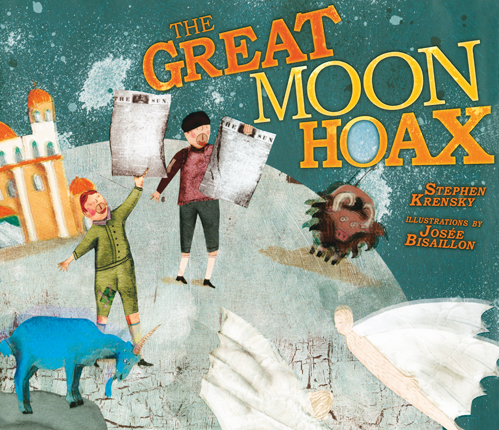Full Text Reviews: School Library Journal - 03/01/2011 Gr 3–5—This picture book is based on an 1835 scandal created by the New York Sun. To increase sales, the newspaper printed fake articles about bizarre creatures on the moon seen through a newfangled telescope, and newsboys Jake and Charlie hawk the sensational editions on the street. The book chronicles some of the details actually published by the Sun as well as the boys' joy over making more money, their hopefulness that the stories are real, and their descent back to reality when the truth is revealed. The story is too simplistic to pare down to a lesson about the wrongs of lying, and the ramifications of a media source's scheme to make money via false claims are too complicated for young readers to process. The rather gloomy collages of quirky faces, figures, and scenes are interesting, but sophisticated. This story would be useful in an older classroom setting to jump-start a discussion of the very relevant issue of journalistic integrity, but that's a pretty limited demographic to consider.—Alyson Low, Fayetteville Public Library, AR - Copyright 2011 Publishers Weekly, Library Journal and/or School Library Journal used with permission. Booklist - 05/01/2011 Charlie and Jake are accustomed to sleeping in an alley, but the two New York Sun newsboys find that their business picks up enormously when the paper reports on discoveries made with a new telescope. Over several days, the Sun describes the moon’s inhabitants, each more fabulous than the one before. For a short while, Jake and Charlie can afford a room in a boardinghouse, but soon they are sleeping in the alley again, while the moon reports are denounced as a hoax. An author’s note provides historical background on the New York Sun and its 1833 moon stories. Through the newsboys, Krensky finds a way to present the story from a child’s point of view. Charlie’s hope that “maybe somebody will start a war” is a bit chilling, but its meaning and his predicament might be good points of discussion with older children. Multimedia collages illustrate the news reports’ fanciful elements as effectively as they express the story’s rather bleak setting and its darker edge. For larger collections. - Copyright 2011 Booklist. Bulletin for the Center... - 06/01/2011 It’s 1835, and for two years the New York Sun has been pioneering the practice of paying newsboys a fixed amount of profit for each newspaper sold. The more enterprising boys quickly caught on that hyping the stories attracts customers, but this week the paper is an easy sell. The Sun has begun a series reporting that the astronomer Sir John Herschel has trained his telescope on the moon and tracked all manner of whimsical creatures cavorting thereon. “A strange amphibious creature of a spherical form, which rolled with great velocity across the pebbly beach” could only be topped by a moon beaver that “carries its young in its arms like a human being” and lives in a hut “constructed better and higher than those of many tribes of human savages.” As a result of these saleable stories, newsboys Jake and Charlie, accustomed to sleeping in the streets, are raking in the pennies, eating well, and spending the nights on clean-sheeted beds. When the series is exposed as a hoax, Jake tempers his disappointment with the knowledge that he truly enjoyed, albeit briefly, indulging his imagination on the stories (“Even if they’re not quite true, they can make us see amazing things”). The paper-thin newsboy framing story seems little more than an excuse to quote excerpts from the Sun articles (although no specific source notes are included for the quotations). Should listeners be as intrigued by the lives of these marginalized street waifs as the tall tales in the Sun, they will find little information provided about their precarious fortunes. Bisaillon’s atmospheric collages carry the day here, melding G. Brian Karas-styled figures with fantastic creatures that fill the boys’ imaginations. An author’s note comments a bit further on the hoax and its probable perpetrator, editor Richard Adams Locke. Older readers with some rudimentary search skills will want to scour the Internet for a fuller account. EB - Copyright 2011 The Board of Trustees of the University of Illinois. Loading...
|



